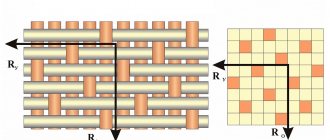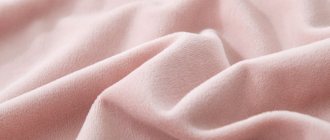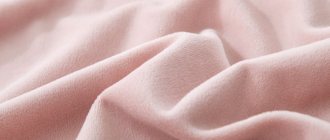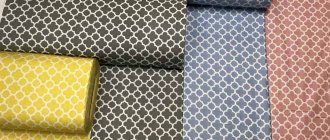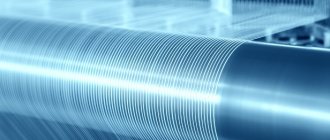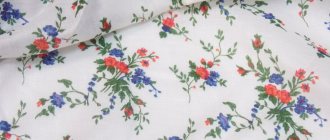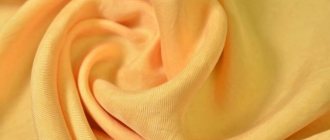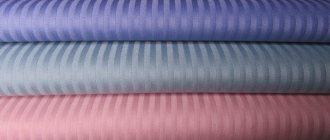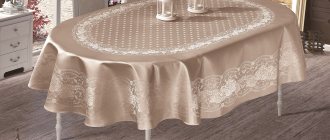Nowadays polyester bedding sets are coming into fashion. It is a product created from toxic substances that undergo a complex cycle of chemical reactions. Several synthetic fabrics are combined under this name. These are durable materials that come in different densities, colors and properties, depending on the percentage of artificial fibers contained in the fabric.
Pure polyester would be very harmful for a bedding set, but since it comes with the addition of natural fibers, its use for sewing this type of product is 100% justified. New technologies make it possible to produce “breathable” synthetic fibers; when intertwined with natural ones, the result is a material that can absorb moisture and allow air to pass through, which is very important for bed linen.
Polyester bedding - good or bad
Artificial fabrics do not wrinkle and shine. Do not cause allergic skin reactions. Even children's underwear is sewn from this material, so it is definitely impossible to say that this fabric is worse than natural fabric; everyone has their own opinion on this matter. Polyester is part of the popular fabric - microfiber. Read reviews about microfiber bedding here.
Polyester is an excellent option for those people who suffer from allergies, do not like to bother with washing for a long time and prefer durable things.
The latest technologies for producing ultrathin fibers were developed in Japan in 1960. And since 1990, this material has already conquered European markets.
We’ll immediately point out the disadvantages of polyester bed linen, because it’s not as long to list them as the advantages. So,
- has a low degree of breathability;
- sometimes there are hard options;
- difficult to repaint. Even the initial dyeing is difficult because the dye does not penetrate the fibers.
How to make the right choice of mattress for a newborn?
Photo of diving fabric: .
What is corn fabric: read the description and reviews.
Advantages over other fabrics
- the material is pleasant to the touch;
- does not wrinkle or roll during operation;
- has high wear resistance;
- has increased strength;
- has an antifungal effect;
- It does not require special care. Even stubborn and greasy stains can be easily washed in cold water at low temperatures;
- dries quickly;
- does not sit down or stretch. Thanks to this, it retains its shape for a long time.
- cools the bed in summer;
- not electrified;
- hypoallergenic;
- the material is resistant to mechanical stress;
- The kit does not include various insects (moths, fleas).
If you become the owner of such a set, then do not rush to immediately make your bed with it. You should first wash and dry it to remove the specific smell and make the material less rigid.
Advantages and disadvantages of viscose fabric
You already know that there are many varieties of viscose, but we will consider the characteristics of 100% viscose without the addition of other fibers. So, viscose has the following qualities:
- Does not cause allergies;
- Has pleasant tactile properties;
- Does not accumulate static electricity;
- Has high breathability and thermal conductivity;
- Holds color for a long time;
- Drapes beautifully.
Like all fabrics, viscose is also not without its drawbacks. For example, it has strong creaseability; viscose requires special care, because... If the material is not properly cared for, the products may become deformed and shrink, as well as become covered in pellets. Another important disadvantage is the wear period: viscose quickly loses its original appearance from ultraviolet rays. It is worth noting that manufacturers are struggling with the disadvantages presented above by adding other fibers.
Bed linen made from other synthetic fabrics
Artificial fabrics are also called mixed fabrics, due to the mixing of natural and artificial fibers. The most common material for sewing sleeping sets is a mixture of polyester and cotton called polycotton. It has absorbed the best characteristics of natural and artificial materials. It contains up to 35% polyester, the rest is cotton. Therefore, this fabric is very soft, pleasant to the touch, and breathable, like natural fabric. But at the same time, it is durable, wear-resistant and durable, like synthetics. The color range of such bed linen is very rich, and over time, your favorite colors will not lose their brightness and richness.
Viscose
Viscose bedding sets are deservedly popular. This fabric is made from natural cellulose. Therefore, it is difficult to distinguish it from cotton. Depending on the thickness and properties of the fibers from which it is made, it turns out to be similar to cotton, linen, wool or silk. Sleeping on such bedding is soft and pleasant; it differs from natural material in its increased hygroscopicity, and you can find out whether viscose or polyester is better in this material.
It has a beautiful shine and is easily painted in various colors. Pure viscose becomes less durable when wet, so manufacturers took this into account and began adding special reinforcing fibers to its composition. It looks especially interesting on the bed, forming wonderful decorative folds. This fabric does not electrify, has good breathability and is hygienic. It is used to create children's sleeping sets. They will be durable, able to withstand a large number of washes and not change their shape.
How to choose a blanket for winter so as not to freeze?
What kind of fabric is spandex: read reviews.
Photo and characteristics of neoprene fabric: .
Poplin
One of the mixed fabrics widely used for sewing bedding sets is poplin. Its structure is surprisingly soft and practical. It is made from cotton, artificial, silk and viscose fibers. A special technique of weaving threads (the base is thin cotton threads, and the guides are twice as thick) ensures high strength and density. Its velvet surface has a matte shine.
Poplin bedding sets can retain their original appearance for a long time. Their colors do not fade. This underwear has a “breathable” effect and retains heat.
The high cost of poplin sets is compensated by durability, preservation of their characteristics and comfort created from use.
Viscose and polyester fabric
It is very similar to real silk, has the same characteristics not only in appearance, but also in tactile sensations: pleasant, soft, light, smooth and has a shiny iridescence.
Natural silk is very expensive, but its artificial counterpart has a much lower price and is in no way inferior to it, and even has a number of features. It is made from viscose and polyester.
Almost similar to it in terms of hygienic properties. But still, it takes longer to heat up than its natural counterpart, so you often have to go to bed in a still cold bed. However, in summer this property is very helpful. Artificial silk sets will not disappoint you when used and will last a long life.
Polyester production technology
How to choose bedding
Polyester for sportswear
When creating polyester, different components of products obtained from oil refining are used. This is a rather complex chemical process that involves ethylene glycol and dimethyl terephthalate. Diglycol ether, when heated to +270 degrees, goes through the stage of polycondensation (during this process, high-molecular compounds are formed). The melted fibers are treated with ethylene oxide, which is produced by catalytic oxidation.
After a series of chemical processes, polystyrene is formed. From this, in turn, polyester fibers are produced by melting and cooling with air. The next stage is stretching the resulting synthetic threads to the required thickness and strength.
Polyester fabric is created by weaving transverse and warp threads, but such fabric is rarely used. More often, natural or synthetic threads are added to polyester fibers during the weaving process. This gives the material a number of unique properties.
Caring for a set of artificial fabrics
Like any clothing or item for long-term use, it requires proper care. It is not complicated, you just need to follow these steps:
- Before washing, all parts of the set should be turned inside out;
- existing zippers, snaps and buttons must be fastened;
- white bedding should be washed separately from colored ones with special powders;
- carefully read the label with the recommended washing temperature;
- load only one set into the drum of the machine, this will ensure a good wash and will not overload the machine itself;
- The use of bleaching agents is not recommended;
- Under no circumstances should such laundry be boiled;
- to soften the material, use conditioner;
- bedding made from artificial fabric should be dried in the open air; it should not be hung on hot radiators;
- such sets do not require ironing, but if you still decide to iron it for additional disinfection, you should do this by selecting the “silk” mode;
- For ease of storage, all parts of the bedding can be placed in one pillowcase, then you don’t have to look for it throughout the closet.
Advantages and disadvantages
Positive properties include:
- Strength, wear resistance. Does polyester stretch or not? This material in its pure form is resistant to stretching and other physical impacts; for elasticity, additional fibers are included in the composition.
- Easy to wash. The fabric dries quickly and hardly wrinkles after washing.
- Polyester retains heat and does not get wet, so it is often used for sewing outerwear. Synthetics protect against adverse weather conditions: wind, rain and snow. These clothes are comfortable to wear in cold weather.
- Polyester is easy to cut and sew textiles. The fabric drapes well.
- This is a light material, pleasant to the body, with a cooling effect.
- High-quality polyester-based materials look beautiful.
- With proper care, it retains its rich color and does not deform.
- The advantage of synthetics is that they are not of interest to insects. There is no need to be afraid of moths and other pests.
- The fabric is resistant to the absorption of odors and the appearance of persistent greasy stains.
- Low cost allows synthetics to compete with natural fabrics in the textile market.
But the material also has a lot of disadvantages:
- He becomes electrified. Due to the accumulation of static electricity, dust sticks to the products, and the fabric itself sticks to the skin. To eliminate this drawback, you have to use an antistatic agent or buy a special conditioner for washing. Some manufacturers add antistatic fibers to the fabric to solve the problem.
- Pure polyester is quite hard and can chafe. To soften the material, natural cotton fibers or elastane are added to it.
- Polyester clothing is not suitable for hot weather due to its density.
- To remove stubborn stains from this type of synthetic fabric, you will have to try, since chemical bleaches damage the fibers.
- Polyester fabric can cause allergies, so such clothes are harmful to health, especially cheap ones.
- The fabric is flammable.
A variety of textures is possible thanks to different ways of weaving threads and adding other fibers. This is how knitwear, lace, and warm linings appear.
Some properties of synthetic matter cannot be clearly described as positive or negative. Thus, low elasticity allows clothes to keep their shape, but partly hinders movement. A controversial property is the ability to change shape when heated. This feature is useful when creating folds: simply iron the fabric with a hot iron and fix the desired fold
But if you use the iron carelessly, this property will play a cruel joke on you: one awkward movement, and a bend will appear that is difficult to get rid of
Reviews
Olga, 48 years old:
After using bed linen for a long time, I came to the conclusion that the weakest link is the sheet. It wears out and breaks the fastest. I heard about a new fabric - polyester, and decided to try it for strength. After the first wash, I was very happy: firstly, there is no need to iron, the fabric does not wrinkle, and secondly, the sheet lay on the bed like a glove. At night it does not crumple or slip, which provides me with a comfortable sleep. I have been using the set for a year now, and it has not faded or stretched, as happens with natural materials. I'm happy with the purchase!
Katerina Vyacheslavovna, 52 years old:
I have always dreamed of silk bedding. But all the time I felt sorry for money. Finally, having heard about a set made of artificial silk, which costs an order of magnitude less, I decided to make a purchase. The fabric really cannot be distinguished from the real thing to the touch. At first it became electrified, especially the pillowcase when it came into contact with the hair, I solved this problem by washing it with conditioner.
I thought that I would slide all over the bed, but my doubts were not justified. But it slips away when ironing; probably, when the fabric is heated, this property appears. That’s why I abandoned this idea, especially since it doesn’t wrinkle very much after washing and can be covered that way.
Galya, 34 years old:
I always thought that microfiber was synthetic and it was impossible to sleep on it. I have not yet bought bed linen, the composition of which is 100% modal. I had never come across such material, so I had to look up its decoding and care on the Internet. It turned out that it was cotton fabric with the addition of artificial fibers. It looks so much like real cotton that you can't tell the difference. This fabric does not fade and washes well. It's wonderful to sleep on, it's so smooth and soft that you don't want to get up in the morning.
Margarita, 28 years old:
I bought a set made of viscose. I want to immediately talk about the positive aspects of this fabric. The main thing is its hygroscopicity. Our little son often sleeps with us, we really didn’t want him to sweat, so this fabric perfectly absorbs excess moisture, even better than natural moisture. Also suitable for allergy sufferers or small children, so as not to cause allergies. It does not shock with electricity, does not fade, but I wash it without spinning and in the delicate wash mode. I haven’t tried others, I don’t want to spoil them and experiment in vain. It dries quickly¸ even in winter. I recommend buying viscose bedding sets not only for yourself, but also for your children.
Also read about the composition of polysatin fabric at the link.
Subtleties of care
The most important point in caring for polyester fabric is the correct washing mode. Fortunately, now in washing machines you don’t need to think about what temperature to set and at what number of revolutions to spin the fabric, since the machine itself, in accordance with the specified program, selects the desired temperature and other washing characteristics. The housewife only needs to turn the pointer to the desired type of fabric, for example, “Synthetics”.
If you wash polyester by hand, you need to remember that this fabric cannot be washed in water whose temperature exceeds 40 degrees. And, of course, you should always look at the fabric tags on the product. They may have signs prohibiting machine washing and dry cleaning.
In addition to this information, on the tags you can also see instructions for ironing synthetic clothes. And if there are no fabric type indicators on the iron, then the notes on the tag will be very helpful. The number of dots on the iron symbol usually indicates at what temperature a particular item is allowed to be ironed. In general, polyester fabric is completely undemanding: it hardly wrinkles, does not fade, and simple stains can often be removed almost immediately after they appear with a regular damp cloth.
